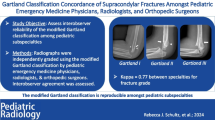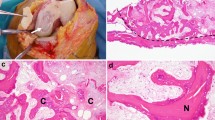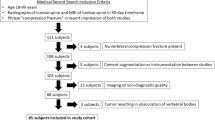Abstract
Background
The classic metaphyseal lesion (CML) is highly specific for non-accidental trauma in infants. While the radiographic findings are well documented, there is little literature on the ultrasound (US) appearance.
Objective
To evaluate US findings in CMLs identified on radiographs.
Material and methods
This institutional review board-approved, retrospective evaluation of targeted US of CMLs was performed in selected groups of children from 2014 to 2017. Only CMLs confidently identified on radiography by a consensus of two radiologists were included. US images were obtained with a linear transducer, including longitudinal images at lateral, anterior, medial and posterior aspects. Two pediatric radiologists evaluated the US appearance, specifically the metaphyseal bone collar for thickness, deformity and fracture, as well as the sonographic zone of provisional calcification for irregularity and appearance of multiple lines. Radiography was the reference standard.
Results
Twenty-two patients (13 female; mean age: 4.2 months) were identified, with 39 CMLs in the tibia (n=22), femur (n=11), humerus (n=3), radius (n=2) and fibula (n=1). Thirty-three of the 39 CMLs (85%) were identified on US, while 6 (15%) were not seen (false negatives). Thirty of the 39 (77%) had metaphyseal bone collar thickening, 29 (74%) had collar deformity and 12 (31%) had visible fracture of the collar. At the sonographic zone of provisional calcification, 16/39 (41%) had irregularity and 5 (13%) had multiple lines visible.
Conclusion
Identifying metaphyseal bone collar and zone of provisional calcification abnormalities is key to recognizing CMLs on US. While additional studies are necessary to evaluate the accuracy of US in the diagnosis of CMLs, our findings suggest US may have a potential role in either confirming or evaluating radiographically equivocal/occult CMLs.







Similar content being viewed by others
References
Expert Panel on Pediatric Imaging, Wootton-Gorges SL, Soares BP et al (2017) ACR appropriateness criteria: suspected physical abuse-child. J Am Coll Radiol 14:S338–S349
Caffey J (1957) Some traumatic lesions in growing bones other than fractures and dislocations: clinical and radiologic features: the Mackenzie Davidson memorial lecture. Br J Radiol 30:225–238
Kleinman PK, Marks SC Jr, Richmond JM, Blackbourne BD (1995) Inflicted skeletal injury: a postmortem radiologic-histopathologic study in 31 infants. AJR Am J Roentgenol 165:647–650
Kleinman PK, Perez-Rossello JM, Newton AW et al (2011) Prevalence of the classic metaphyseal lesion in infants at low versus high risk for abuse. AJR Am J Roentgenol 197:1005–1008
Kleinman PK, Belanger PL, Karellas A, Spevak MR et al (1991) Normal metaphyseal radiologic variants not to be confused with infant abuse. AJR Am J Roentgenol 156:781–783
Kleinman PK, Sarwar ZU, Newton AW et al (2009) Metaphyseal fragmentation with physiologic bowing: a finding not to be confused with the classic metaphyseal lesion. AJR Am J Roentgenol 192:1266–1268
Jenny C, Hymel KP, Ritzen A et al (1999) Analysis of missed cases of abuse head trauma. JAMA 281:621–626
Perez-Rossello JM, Connolly SA, Newton AW et al (2010) Whole-body MRI in suspected infant abuse. AJR Am J Roentgenol 195:744–750
Drubach LA, Johnston PR, Newton AW et al (2010) Skeletal trauma in child abuse: detection with 18F-NaF PET. Radiology 255:173–181
Oestreich AE, Ahmad BS (1992) The periphysis and its effect on the metaphysis: I. Definition and normal radiographic pattern Skeletal Radiol 21:283–286
Kleinman PK (2015) Lower extremity trauma; upper extremity trauma. In: Kleinman P (ed) Diagnostic imaging of child abuse, 3rd edn. St. Louis, MO: Mosby-Year Book
Kleinman PK, Marks SC, Blackbourne B (1986) The metaphyseal lesion in abused infants: a radiologic-histopathologic study. AJR Am J Roentgenol 146:895–905
Kleinman PK, Marks SC Jr (1995) Relationship of the subperiosteal bone collar to the metaphyseal lesion in abused infants. J Bone Joint Surg Am 77:1471–1476
Tsai A, Coats B, Kleinman PK (2017) Biomechanics of the classic metaphyseal lesion: finite element analysis. Pediatr Radiol 47:1622–1630
Markowitz RI, Hubbard AM, Harty MP et al (1993) Sonography of the knee in normal and abused infants. Pediatr Radiol 23:264–267
Supakul N, Hicks RA, Caltoum CB, Karmazyn B (2015) Distal humeral epiphyseal separation in young children: an often-missed fracture-radiographic signs and ultrasound confirmatory diagnosis. AJR Am J Roentgenol 204:W192–W198
Karmazyn B, Duhn RD, Jennings SG et al (2012) Long bone fracture detection in suspected child abuse: contribution of lateral views. Pediatr Radiol 42:463–469
Kleinman PK, Nimkin K, Spevak MR et al (1996) Follow-up skeletal surveys in suspected child abuse. AJR Am J Roentgenol 167:893–896
Kleinman PK, Marks SC Jr, Spevak MR et al (1991) Extension of growth-plate cartilage into the metaphysis: a sign of healing fracture in abused infants. AJR Am J Roentgenol 156:775–779
Osier LK, Marks SC Jr, Kleinman PK (1993) Metaphyseal extensions of hypertrophied chondrocytes in abused infants indicate healing fractures. J Pediatr Orthop 13:249–254
Tsai A, Kleinman PK (2018) How often is subperiosteal new bone formation noted with the distal tibia classic metaphyseal lesion? Pediatr Radiol 48:S94–S95
Tsai A, Johnston PR, Perez-Rossello JM et al (2018) The distal tibial classic metaphyseal lesion: medial versus lateral cortical injury. Pediatr Radiol 48:973–978
Author information
Authors and Affiliations
Corresponding author
Ethics declarations
Conflicts of interest
None.
Additional information
Publisher’s note
Springer Nature remains neutral with regard to jurisdictional claims in published maps and institutional affiliations.
Rights and permissions
About this article
Cite this article
Marine, M.B., Hibbard, R.A., Jennings, S.G. et al. Ultrasound findings in classic metaphyseal lesions: emphasis on the metaphyseal bone collar and zone of provisional calcification. Pediatr Radiol 49, 913–921 (2019). https://doi.org/10.1007/s00247-019-04373-w
Received:
Revised:
Accepted:
Published:
Issue Date:
DOI: https://doi.org/10.1007/s00247-019-04373-w




